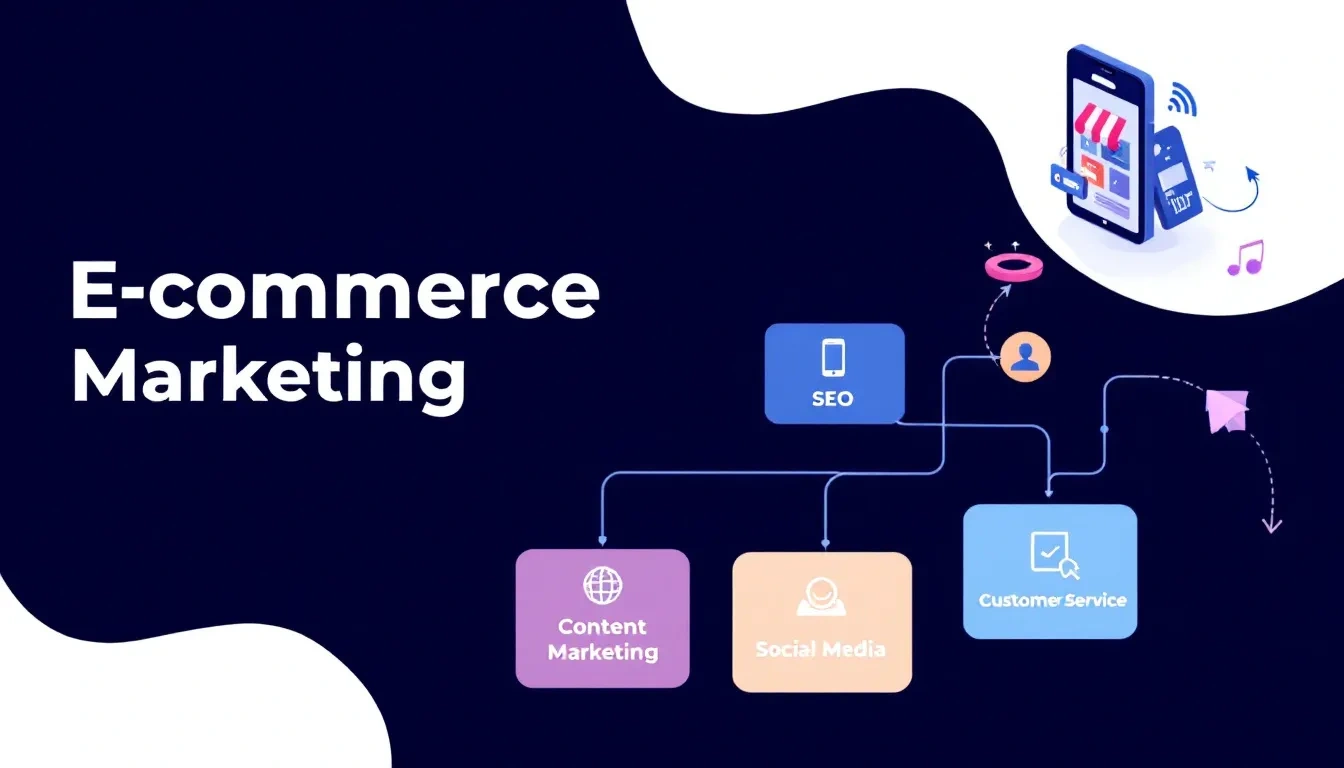Table of Contents[Hide][Show]
- Key Insights
- Summary
Frequently Asked Questions+−
- What is the importance of setting clear objectives and KPIs in ecommerce marketing?
- How can understanding your target audience improve your ecommerce marketing strategy?
- Why is SEO and content marketing important for ecommerce?
- How does influencer marketing benefit ecommerce businesses?
- What are the key considerations for international ecommerce marketing?
Want to boost your online sales and outperform competitors in 2025? This article will guide you through a robust ecommerce marketing strategy. Discover proven tactics for driving traffic, increasing conversions, and retaining loyal customers. From social media hacks to SEO tips, prepare for a comprehensive walkthrough to elevate your ecommerce game. Platforms like Facebook, Instagram, and TikTok are vital for promoting shopping features and user content. They boost engagement and drive sales.
Key Insights
- A robust e-commerce marketing strategy should integrate on-site and off-site tactics, including social media platforms, and focus on driving traffic, increasing sales, and retaining customers.
- Understanding the target audience through detailed buyer personas and thorough market research is essential for crafting effective marketing strategies.
- Utilizing data analytics to track key metrics, conduct A/B testing, and regularly analyze performance can significantly optimize e-commerce marketing efforts.
Understanding Ecommerce Marketing
Ecommerce marketing is a crucial aspect of any online business, and it’s essential to understand its core principles to succeed in the competitive digital landscape. At its heart, e-commerce marketing uses various digital channels to attract visitors, convert them into paying customers, and retain them for future purchases. This multifaceted approach ensures that your online store gains visibility and fosters long-term customer relationships.
A successful ecommerce marketing strategy integrates multiple tactics, including search engine optimization (SEO), social media marketing, email marketing, and content marketing. By effectively leveraging these channels, you can drive traffic to your e-commerce store, enhance user engagement, and ultimately boost sales. Understanding the nuances of e-commerce marketing is the first step toward creating a robust strategy that can propel your business forward.
Ecommerce Marketing vs Digital Marketing
While ecommerce marketing strategies and digital marketing strategies are often used interchangeably, they have distinct differences that are important to understand. Digital marketing is a broad term that encompasses all forms of online marketing, including search engine optimization (SEO), social media marketing, email marketing, and more. It aims to promote brands, build an online presence, and engage with audiences across various digital platforms.
E-commerce marketing is more specific and focuses on selling products or services online. Strategies include optimizing pages, running ads, and running email campaigns. Knowing the differences helps tailor efforts and achieve goals.
Tips for Developing a Robust Ecommerce Marketing Strategy

A full ecommerce marketing strategy is needed to promote and sell online. It should use various tactics and channels to turn visitors into loyal customers. The main goals are to drive traffic, boost sales, and retain customers. This makes it complex. A successful strategy blends on-site and off-site tactics for a broad reach.
Social media platforms like Facebook, Instagram, and TikTok are vital. They promote products and engage customers through ads, shopping features, and user content.
A clear strategy links all channels and activities and aims to increase order value and sales. Using multiple tactics helps attract traffic, convert visitors, and retain customers.
Setting Clear eCommerce Objectives and KPIs
Clear objectives and KPIs are vital for e-commerce marketing. Goals such as revenue growth, gaining market share, and launching products focus your strategy. Consider factors like industry, location, and size when setting these goals. For example, an e-commerce business might aim to boost website traffic, increase conversion rates, and lower customer acquisition costs. Social media can promote shopping features and user content.
KPIs are crucial for measuring marketing performance. Key metrics include customer acquisition cost, average order value, and conversion rates. These offer insights into strategy effectiveness. Regularly monitor these KPIs to keep your plan on track and adapt to market changes.
Understanding Your Target Audience
Knowing your target audience is key to a successful ecommerce marketing strategy. Knowing customer demographics allows you to segment your audience and craft targeted messaging. Knowing different demographics means your marketing stays relevant and inclusive. For example, looking at customer behavior (purchase history) can help refine your marketing and better meet customer needs. Social media platforms can gather data on customer demographics and behavior.
Detailed buyer personas are created by researching and analyzing demographic information, behavior, and preferences. These fictional representations of your ideal customer guide your marketing in a more focused direction.
Know your target audience, engage customers, and build brand awareness.
Conducting Thorough Market Research
Market research is critical to understanding customer needs and trends. Methods like surveys, interviews, focus groups, and online research give valuable customer insight. Customer surveys, in particular, give you data on preferences, pain points, and product feedback to make better decisions.
Competitor research is another essential part of market research. Knowing your competitor’s strengths and weaknesses helps you shape your strategy to stand out. For example, researching your competitor’s market positioning enables you to adjust your approach to stay competitive. Social media platforms can be used to analyze competitors’ strategies and market positioning, providing insights into their customer engagement and promotional tactics.
Local market knowledge is vital, especially if you’re going global. Research your market and tailor your approach so your marketing attracts customers.
Allocating Budget
Setting a budget for e-commerce marketing is crucial for success. First, decide how much to spend on channels like social media, email, and content. A standard guideline is to spend 5-20% of revenue on marketing, depending on your ROI. Yet, this can change based on your goals, industry, and audience.
For example, a new business might invest heavily in ads to gain visibility. In contrast, an established business might focus on email marketing and loyalty programs. Regularly review and adjust your budget based on performance to stay effective and aligned with goals.
Choosing the Right EcommerceMarketing Channels

Choosing the right marketing channels can make all the difference in e-commerce. Different products perform better on different channels. Lifestyle products do well on social media platforms like Facebook, Instagram, and TikTok, which are used not only for advertising but also for promoting shopping features and user-generated content. B2B services perform better on search engines. Consider your target audience and product when choosing marketing channels.
This section will cover three main marketing channels: Social Media Marketing, Email Marketing, SEO, and Content Marketing. Each has its benefits and can supercharge your e-commerce marketing efforts.
Social Media Marketing
Social media platforms are great for younger audiences and visual products. 78% of US customers find new products through social media platforms like Facebook, Instagram, and TikTok. These platforms are used for advertising and promoting shopping features and user-generated content, which enhances customer engagement and drives sales. TikTok and Instagram are great for short-form videos, which is super effective for e-commerce marketing. For example, through creative content, TikTok helps you build relationships with your target audience.
A social media presence allows online stores to talk directly to customers and promote their mission and values. Posting great photos and participating in reels, stories, and contests on Instagram can build a loyal following.
Email Marketing
Email marketing is one of the best ways to get sales and repeat customers. Segmenting your email list allows for more targeted messaging and higher open and click-through rates. For example, hyper segmenting means creating different campaigns for different segments that are more relevant and engaged.
Automation is critical in email marketing, especially for drip campaigns that send timely emails triggered by user actions like welcome messages and abandoned cart reminders. Tools like Klaviyo can set up abandoned cart email workflows to recover lost sales.
Email marketing is key to any strategy as one of the highest ROI channels in digital marketing. It helps you sell, connect, and retain customers.
SMS Marketing
SMS marketing is a highly effective way to reach your target audience and drive sales. With an open rate of 98%, SMS marketing offers a higher engagement rate than email marketing. To get started with SMS marketing, you’ll need to build a list of subscribers who have opted-in to receive promotional messages from your brand. This can be done through website sign-ups, in-store promotions, or social media campaigns.
Once you have a subscriber list, you can use SMS marketing automation tools to send targeted messages, promotions, and updates to your subscribers. These tools allow you to segment your audience based on their behavior and preferences, ensuring that your messages are relevant and timely. By leveraging SMS marketing, you can enhance customer engagement, drive traffic to your online store, and boost sales.
SEO for Ecommerce
SEO is critical to getting traffic and sales to an e-commerce website. A solid SEO strategy makes your website visible and attracts organic traffic. Keyword research around customer queries is at the heart of an SEO strategy.
Example: Optimizing product pages for search engines means using short, product-specific keywords in titles, headers, and image alt text.
Content Marketing
Content marketing, at the core, involves creating valuable content to attract customers and drive sales.
Examples of content include blog posts, podcasts, social media posts, and user-generated content.
Blogging and SEO articles regularly can boost search engine rankings. Internal linking helps SEO by creating page structure and telling search engines what pages are important.
Ecommerce Paid Advertising Strategies

Paid advertising helps e-commerce reach more people and increase traffic, conversions, and revenue. Its benefits include instant traffic, powerful targeting, and massive audience reach. Common online ads used in e-commerce marketing are display ads, banner ads, and rich media ads.
In general, for eCommerce, social media platforms are used predominantly for targeted advertising and driving traffic to e-commerce stores.
This section will cover three paid advertising strategies: pay-per-click (PPC) advertising, social media ads, and retargeting campaigns. Each has its benefits for your e-commerce marketing efforts.
Pay-Per-Click (PPC) Advertising
Pay-per-click (PPC) advertising involves bidding on keywords to show ads in search results and on related websites. Common platforms for PPC advertising are Google AdWords and Facebook. PPC campaigns target specific audiences based on location, age, and device type. For example, a luxury watch business could target people interested in high-end watches.
According to Google, the average return on investment for PPC advertising is $8 for every $1 spent.
Social Media Ads
Social media ads increase brand awareness and drive traffic to your online store. Social media platforms like TikTok, Facebook, and Instagram are great for eCommerce advertising. These platforms are used for targeted advertising and increasing brand awareness. You don’t need to break the bank to create ads; low-budget graphics can work, too.
These ads allow you to target specific audiences based on demographics, interests, and behaviors, making them a powerful tool for reaching potential customers. Social media ads help e-commerce businesses boost sales and build brand awareness.
Retargeting Campaigns
Retargeting shows ads to customers who have interacted with the business. Facebook, Instagram, and Google Ads are common platforms for retargeting. Familiarity with the brand and product increases the chance of conversion during retargeting.
Retargeting can be used to reengage users who have viewed specific landing pages. Retargeting can increase conversions and sales by reminding potential customers of products they’ve shown interest in.
Enhancing Customer Experience
Reducing cart abandonment and increasing sales is all about customer experience. Addressing customer objections head-on can help reduce cart abandonment. One of the main reasons for abandonment is a need for more trust in the business, product, or delivery. Features like 360-degree views, zoom-in, 3D modeling, and augmented reality can enhance product visuals and customer experience.
Social media platforms like Facebook, Instagram, and TikTok can also be used to engage with customers and enhance their shopping experience by promoting user-generated content and shopping features.
This section will cover three areas to enhance customer experience: Mobile Optimization, User-Friendly Website Design, and Live Chat and Customer Support. Each area has strategies to improve the shopping experience and encourage customers to buy.
Mobile Optimization
More than 60% of website traffic is from mobile devices, so you need a mobile-optimized e-commerce site. Mobile shopping cart abandonment rates are scary, at 70.19%, so you need a mobile-optimized experience. Seamless navigation and mobile shopping are crucial to user experience and reducing abandonment rates.
One key to user experience is optimizing for mobile, which means your site is mobile-friendly when you’re A/B testing to give the best shopping experience. This means responsive design, easy navigation, optimized images, and simplified checkout.
User-Friendly Website Design
A user-friendly website is critical to a smooth customer experience. Responsive design, easy navigation, optimized images, bigger fonts, and simpler checkout processes are all important. Designing for mobile users means more oversized buttons and faster image loading for usability.
A well-designed e-commerce store website like Outdoor Voices is an excellent example of a good layout and user experience.
Live Chat and Customer Support
Live chat talks to your visitors directly and answers their questions instantly. 62% of customers prefer chatbots over humans for quick help. Customer support has many channels, including email, live chat, phone, and social media.
Self-service options can significantly reduce customer support tickets and improve overall efficiency. A multilingual knowledge base can support customers in multiple languages, making support even more streamlined.
Reducing Abandoned Carts
Reducing abandoned carts is vital in e-commerce marketing. The Baymard Institute notes that 70.19% of shopping carts must be included. You can cut this number by using email recovery, retargeting ads, and offering discounts or free shipping. These methods remind customers and encourage purchases.
Analytics tools can also help you understand why carts are abandoned. This allows for better decisions to enhance the user experience. For instance, making checkout easier, adding payment options, and clarifying shipping can lower abandonment rates. Fixing these issues boosts customer satisfaction, increases conversions, and raises sales.
To create a successful e-commerce strategy, understand marketing, use the budget wisely, leverage SMS marketing, and reduce abandoned carts. This approach will drive sales, revenue, and growth.
Leveraging Influencer and Affiliate Marketing

Teaming up with affiliates and influencers boosts e-commerce reach and credibility. Influencers market products to their followers, making genuine connections. Meanwhile, affiliates do so for a commission, driving traffic to your site. Platforms like Facebook, Instagram, and TikTok are key for influencers to promote products and connect with their audience.
This section will cover two approaches: Influencer Marketing Campaigns and Affiliate Marketing Programs. Both have benefits, including boosting sales and building brand awareness.
Influencer Marketing Campaigns
Influencer marketing significantly impacts buying decisions. Thirty percent of consumers consider influencer recommendations important to their buying decisions. Influencing can increase brand awareness, which is super helpful for new e-commerce businesses.
Brands can work with big-budget influencers or micro-influencers; each has its marketing advantages. Micro-influencers, in general, are cheaper and more effective. So, if you are new to the influencer world, that is where you want to start.
Affiliate Marketing Programs
Affiliate marketing lets affiliates earn commissions by promoting products. A strong affiliate program offers commissions to partners, boosting traffic and sales.
Affiliates get a unique affiliate link or tracking code to attribute sales they make. Brands can benefit by launching products, building brand awareness, and increasing sales.
Examples: HubSpot affiliates get a 30% recurring commission for sales made through their affiliate link.
Utilizing Data and Analytics to Analyze and Adjust E-Commerce Strategies

Using data and analytics is key to your e-commerce strategy. Data analysis provides insights, trends, and decision-making support. Use them to adjust your strategy on a regular basis. Knowing your business-critical metrics is key to measuring and improving your e-commerce marketing strategy.
This section will cover three areas: Tracking Metrics, A/B Testing, and Reporting and Analysis. Each area uses data differently to improve e-commerce marketing efforts.
Tracking Key Metrics
It would be best if you tracked your metrics to measure your marketing. E-commerce marketing KPIs are conversion rate and revenue. Key metrics include customer acquisition cost (CAC) and average order value (AOV).
Both website and social media analytics can add to your CRM data and help you understand your target audience. Look at the website conversion funnel to see where people drop off and optimize the conversion.
A/B Testing
A/B testing compares two or more versions of something to see which performs better. In e-commerce, it’s often applied to product images, descriptions, and pricing.
Testing different versions of your marketing assets means you can refine your approach based on your audience data and find what works best to get customers and sales.
Reporting and Analysis
Reporting and data analysis are crucial to finding trends and optimizing e-commerce marketing. Data analysis gives you insight into customer behavior and market trends, allowing you to refine and adjust your marketing to meet customer needs.
Data insights will give you a competitive edge and long-term success in e-commerce. Data analysis is critical to competitive edge and long-term success in e-commerce.
Building Customer Loyalty
Customer loyalty is key to customer retention and sales in a competitive world. A small percentage of your business comes from many repeat customers. Consistency with your customers leads to more loyalty and more repeat purchases. Social media is the most influential channel for engaging and building customer loyalty, so make sure you have a well-established social media presence.
This section will cover three strategies: Loyalty Programs, Personalized Marketing, and User-Generated Content. Each has its benefits and can boost customer loyalty and sales.
Loyalty Programs
Customer loyalty can be driven by point-based programs that reward purchases. Point-based programs can also reward customers for referrals. A customer loyalty program can reward your loyal customers and get them to come back.
Personalized Marketing
Personalization is critical in e-commerce, as it gives customers a bespoke experience. Ways to personalize customer experiences include personalized emails, product recommendations, and offers based on their preferences.
Key Insight: Recommendations based on customer data will increase engagement and sales. A 15% discount will encourage cart abandoners to complete checkout.
Encouraging User-Generated Content
User-generated content is social proof; it helps build brand trust. Users see user-generated content as 2.4 times more authentic than brand-created content. Using user-generated content can build trust and credibility in e-commerce businesses.
UGC can be reviews and videos on product pages and social media for content marketing.
International Ecommerce Marketing Strategy Tips
Going global is a whole new ball game for e-commerce businesses. To find the best international markets, you need to look at digital transaction volume and population size. Knowing local customs, duties, and taxes is key when entering new markets.
This section will cover three areas: Localizing Content, Local Payment Methods, and Shipping and Logistics. Each area has its own strategies for reaching and engaging with a global audience.
Localizing Content
You need to know the audience’s likes, dislikes, and habits. Hiring local experts will give you valuable insights for your local marketing. Localization is more than translation, it’s adapting to local language and consumer behavior.
Example: Product images and graphics must be adjusted to local taste, and local customs must be considered.
Understanding Local Payment Methods
Understanding local payment methods is critical to building customer trust and transaction success. Payment methods need to be tailored to local laws and consumer payment preferences.
Navigating Shipping and Logistics
Shipping and logistics are a big part of international commerce. Working with a good shipping company means your products get delivered. Third-party logistics providers can reduce risks and speed up international shipping.
Following local customs regulations prevents delays, and international transactions go smoothly. Smooth delivery depends on good shipping partners and global rules.
Summary
Creating a solid ecommerce marketing strategy involves setting clear goals, understanding your audience, and analyzing the market. You should also choose the right marketing channels, use paid ads, and enhance the customer journey to boost sales. Furthermore, adopt influencer and affiliate marketing. Use data analytics and build customer loyalty. Additionally, leverage social media platforms like Facebook, Instagram, and TikTok to increase traffic, engagement, and sales. For global expansion, understand regional traditions. We really have just scratched the tip of the iceberg known as e-commerce marketing, so make sure you explore the topics above in more detail.
Frequently Asked Questions
What is the importance of setting clear objectives and KPIs in ecommerce marketing?
Establishing precise goals and key performance indicators (KIPs) is essential for directing your marketing efforts effectively, enabling you to gauge their success and maintain alignment with your strategic ambitions.
How can understanding your target audience improve your ecommerce marketing strategy?
By gaining a deep understanding of your target audience, you can refine your marketing strategy. This allows for the customization of messaging and the development of buyer personas, leading to better engagement with customers and higher conversion rates.
Why is SEO and content marketing important for ecommerce?
Content marketing and SEO are vital for eCommerce because they improve your website’s visibility, draw in organic traffic, bolster trust and authority, which consequently leads to a boost in sales.
How does influencer marketing benefit ecommerce businesses?
Influencer marketing significantly benefits ecommerce businesses by enhancing credibility through trusted endorsements, which expands reach and ultimately drives sales.
What are the key considerations for international ecommerce marketing?
For successful international e-commerce marketing, it’s crucial to tailor content for a global audience by localizing it, grasping the preferred payment methods of each locale, and navigating through the challenges related to shipping and logistics.

 What is Generative Engine Optimization (GEO)?
What is Generative Engine Optimization (GEO)?